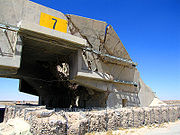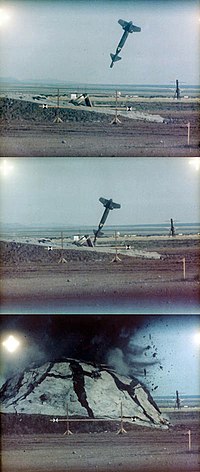A bunker buster is a bomb designed to penetrate hardened targets or targets buried deep underground.
Artillery delivered bombs[]
Germany[]
Röchling shells were bunker-busting artillery shells, developed by German engineer August Cönders, based on the theory of increasing sectional density to improve penetration. They were tested in 1942 and 1943 against the Belgian Fort d'Aubin-Neufchâteau[1]
Aircraft delivered bombs[]
World War II[]
United Kingdom[]

A U-Boat pen after being hit by a Grand Slam — there is a figure standing on the pile of rubble.
In World War II the British designer Barnes Wallis, already famous for inventing the bouncing-bomb, designed two bombs that would become the conceptual predecessors of modern bunker busters: the five tonne Tallboy and the ten tonne Grand Slam "Earthquake" bombs. The designs were very aerodynamic with a tail which caused them to spin. This allowed them to exceed the speed of sound as they fell from 22,000 ft (6,700 m). They had casings of high grade steel, much stronger than the typical WWII bomb so that they would survive hitting a hardened surface, or penetrate deep into the ground.
Though these bombs might be thought of as 'bunker busters' today, in fact the original 'earthquake' theory was more complex and subtle than simply penetrating a hardened surface. The Earthquake bombs were designed not to strike a target directly, but to impact beside it, penetrate under it, and create a 'camouflet' or large buried cavern at the same time as delivering a shock wave through the target's foundations. The target then collapses into the hole, no matter how hardened it may be. The bombs had strong casings because they needed to travel through rock rather than reinforced concrete, though they could perform equally well against hardened surfaces. In an attack on the Valentin U-Boat pens at Farge two Grand Slams went through the 15 ft (4.5 m) reinforced concrete hardening[2] — equalling or exceeding the best current penetration specifications.
The British Disney Rocket-Assisted Bomb was another WW2 device to be used against U-boat pens and other super-hardened targets. Devised by Captain Edward Terrell RNVR of the Admiralty's Directorate of Miscellaneous Weapons Development[3] it had a streamlined hardened case and weighed some 4,500 kilograms (9,900 lb) including the rocket assembly. Actual explosive content was about 500 lb (230 kg).
For accuracy, the bombs had to be dropped precisely from a pre-determined height (usually 20,000 feet (6,100 m)).[4] They would free-fall for around 30 seconds until, at 5,000 feet (1,500 m), the rockets were ignited, causing the tail section to be expelled.[4] The rocket burn lasted for three seconds[5] and added 300 feet per second (91 m/s) to the bomb's speed, giving a final impact speed of 1,450 feet per second (440 m/s; 990 mph),[5] approximately Mach 1.29.[lower-alpha 1] Post-war tests demonstrated the bombs were able to penetrate a 14-foot-8-inch (4.47 m) thick concrete roof,[6] with the predicted (but untested) ability to penetrate 16 feet 8 inches (5.08 m) of concrete.[6]
United States[]
Post war the US added a form of remote guidance to the Tallboy to create the Tarzon, a 12,000-pound bomb deployed in the Korean War against an underground command center near Kanggye.
Modern[]

An example of bunker busters at work at Ali Al Salem Air Base, Kuwait
During Operation Desert Storm (1991) there was a need for a deep penetration bomb similar to the British weapons of WWII, but none of the NATO air forces had such a weapon. As a stop-gap, some were developed over a period of 28 days, using old 8 inch (203 mm) artillery barrels as casings. These bombs weighed over two tons but carried only 647 lb (293 kg) of high explosive. They were laser-guided and were designated "Guided Bomb Unit-28 (GBU-28)". It was proved to be effective for the intended role.
An example of a Russian bunker buster is the KAB-1500L-Pr. It is delivered with the Su-24M and the Su-27IB aircraft. It is stated to be able to penetrate 10–20 m of earth or 2 m of reinforced concrete. The bomb weighs 1,500 kg (3,300 lb), with 1,100 kg (2,400 lb) being the high explosive penetrating warhead. It is laser guided and has a reported strike accuracy of 7 m (23 ft) CEP.
The US has a series of custom made bombs to penetrate hardened or deeply buried structures:
| Depth of Penetration | Weapon Systems | |
|---|---|---|
| Penetration of reinforced concrete: 1.8 m (6 ft) | BLU-109 Penetrator | GBU-10, GBU-15, GBU-24, GBU-27, AGM-130 |
| Penetration of reinforced concrete: 3.4 m (11 ft) | BLU-116 Advanced Unitary Penetrator (AUP) | GBU-15, GBU-24, GBU-27, AGM-130 |
| BLU-118/B Thermobaric Warhead | GBU-15, GBU-24, AGM-130 | |
| Penetration of reinforced concrete: more than 6 m (20 ft) | BLU-113 Super Penetrator | GBU-28, GBU-37 |
More recently, the US has developed the 30,000-pound GBU-57.
Fuzing[]
The traditional fuze is the same as a classic armor-piercing bomb: a combination of timer and a sturdy dynamic propeller on the rear of the bomb. The fuze is armed when the bomb is released, and detonates when the propeller stops turning and the timer has expired.
Modern bunker busters may use the traditional fuze, but some also include a microphone and microcontroller. The microphone listens, and the micro controller counts floors until the bomb breaks through the desired numbers of floors.
ATK is working on a Hard Target Void Sensing Fuze (HTVSF) for 2000 and 5000 pound weapons to explode when they reach an open space in a deeply buried bunker.[7]
Missiles[]

A guided bomb strikes its target in a weapons test
The extra speed provided by a rocket motor enables greater penetration of a missile-mounted bunker buster warhead. To reach maximum penetration (impact depth), the warhead may consist of a high-density projectile only. Such a warhead carries more energy than a warhead with chemical explosives (kinetic energy of a projectile at hypervelocity).
Nuclear[]
The nuclear bunker buster is the nuclear weapon version of the bunker buster. The non-nuclear component of the weapon is designed to greatly enhance the penetration into soil, rock, or concrete to deliver a nuclear warhead to a target. These weapons would be used to destroy hardened, underground military bunkers buried deep in the ground. In theory, the amount of radioactive nuclear fallout would be reduced from that of a standard, air-burst nuclear detonation because they would have relatively low explosive yield. However, because such weapons necessarily come into contact with large amounts of earth-based debris, they may, under certain circumstances, still generate significant fallout. Warhead yield and weapon design have changed periodically throughout the history of the design of such weapons. An underground explosion releases a larger fraction of its energy into the ground, compared to an explosion at or above the surface which releases most of its energy into the atmosphere.
See also[]
- T-12 Cloudmaker
- Disney bomb
- Rochling shell
Notes[]
- ↑ Other sources mention a striking speed of 2,400 feet per second (730 m/s; 1,600 mph). (Johnsen 2003, p. 45, Burakowski & Sala 1960, p. 556)
- ↑ http://derelicta.pagesperso-orange.fr/aubin3.htm
- ↑ RAF staff 2005, Grand Slams.
- ↑ Terrell 1958, pp. 197-212.
- ↑ 4.0 4.1 Burakowski & Sala 1960, p. 556
- ↑ 5.0 5.1 Project Ruby 1946, p. 18
- ↑ 6.0 6.1 Project Ruby 1946, p. 23
- ↑ "ATK Awarded Contract for Hard Target Void Sensing Fuze (HTVSF) Engineering & Manufacturing Development (EMD) Phase." ATK, 5 April 2011.
References[]
- Air Proving Ground Command Eglin Field (31 October 1946). Comparative Test of the Effectiveness of Large Bombs against Reinforced Concrete Structures (Anglo-American Bomb Tests – Project Ruby). Orlando, Florida: US Air Force. http://www.dtic.mil/cgi-bin/GetTRDoc?AD=ADA065940&Location=U2&doc=GetTRDoc.pdf. Retrieved 9 June 2011CITEREFProject_Ruby1946. "Running parallel with the development of large bombs was a project for obtaining high striking velocities by means of a rocket assisted 4,500-lb British bomb called the Disney. (...) As early as June 1945, the concrete V-weapon structure at Watten was used as a target".
- Burakowski, Tadeusz; Sala, Aleksander (1960) (in Polish). Rakiety i Pociski Kierowane [Rockets and guided missiles]. Część 1 – Zastosowania (Volume 1 – applications). Warsaw: Wydawnictwo Ministerstwa Obrony Narodowej (Ministry Of National Defense Publishing House). pp. 556–557. Figure 280, p. 558, provides a detailed diagram of the Disney bomb (with its internals).
- Johnsen, Frederick A. (2003). Weapons of the Eighth Air Force. St. Paul, MN: MBI Publishing. p. 45. ISBN 0-7603-1340-7. http://books.google.com/books?id=S5USfmKSCD4C&lpg=PA45&dq=%22disney%20bomb%22&pg=PA45#v=onepage&q&f=false.
- RAF staff (6 April 2005). "RAF: Bomber Command: Grand Slams". Archived from the original on 6 July 2007. http://webarchive.nationalarchives.gov.uk/20070706011932/http://www.raf.mod.uk/bombercommand/grandslam.html.
- Terrell, Edward (1958). Admiralty Brief: the story of inventions that contributed to victory in the Battle of the Atlantic. Harrap.
Further reading[]
- Alekseevskii, V. P. (1966). "Penetration of a rod into a target at high velocity". pp. 99–106. Digital object identifier:10.1007/BF00749237. ISSN 0010-5082.
- Bernard, Robert S. (1978). Depth and Motion Prediction for Earth Penetrators (Report). ADA056701. Army Engineer Waterways Experiment Station Vicksburg. http://www.dtic.mil/cgi-bin/GetTRDoc?Location=U2&doc=GetTRDoc.pdf&AD=ADA056701.
- Parsch, Andreas (2006). "Textron (Avco) BLU-106/B BKEP (Boosted Kinetic Energy Penetrator)". Directory of U.S. Military Rockets and Missiles fitted with bunker busting bombs to extend distances and to have horizontal as well as vertical movement and controll. (Appendix 4). http://www.designation-systems.net/dusrm/app4/blu-106.html. Retrieved 27 June 2011. US rocket-boosted submunition against runways and hardened aircraft shelters.
- Segletes, Steven B.; Walters, William P. (2003). "Extensions to the exact solution of the long-rod penetration/erosion equations". pp. 363–376. Digital object identifier:10.1016/S0734-743X(02)00071-4. http://aux.ciar.org/ttk/mbt/papers/ijie00/ijie_28_363.pdf. Retrieved 23 June 2011.
- Tate, A. (1 November 1967). "A theory for the deceleration of long rods after impact". pp. 387–399. Digital object identifier:10.1016/0022-5096(67)90010-5. http://hep.ph.liv.ac.uk/~ibailey/target/shielding/tate_1967.pdf. Retrieved 23 June 2011.
- Segletes, Steven B.; Walters, William P. (2002). Efficient Solution of the Long-Rod Penetration Equations of Alekseevskii-Tate (Report). ARL-TR-2855. Army Research Lab Aberdeen Proving Ground MD. http://www.arl.army.mil/arlreports/2002/ARL-TR-2855.pdf.
- Walters, William P.; Segletes, Steven B. (1991). "An exact solution of the long rod penetration equations". pp. 225–231. Digital object identifier:10.1016/0734-743X(91)90008-4.
- Young, C.W. (1997). Penetration equations (Report). SAND94-2726. Albuquerque NM: Sandia National Laboratories. http://www.fas.org/sgp/othergov/doe/lanl/lib-www/sand/972426.pdf. "This is a standalone report documenting the latest version of the Young/Sandia penetration equations and related analytical techniques to predict penetration into natural earth materials and concrete."
- Young, C.W. (1967). The Development Of Empirical Equations For Predicting Depth Of An Earth Penetrating Projectile (Report). SC-DR-67-60. Albuquerque NM: Sandia National Laboratories.
External links[]
- Guided Bomb Unit-28 (GBU-28) BLU-113 Penetrator
- BBC: 'Bunker buster' missiles aim at Moon
- Annotated bibliography for nuclear bunker buster bombs from the Alsos Digital Library for Nuclear Issues
- Read Congressional Research Service (CRS) Reports regarding Bunker Busters
- Video against usage (produced by Union of Concerned Scientists)
- (Project spider; Massive natural passive defense against air raid by anna farahmand)
- Video of bunker buster bomb in action
- Tunnel buster bomb
- Bunker buster
The original article can be found at Bunker buster and the edit history here.